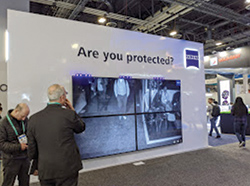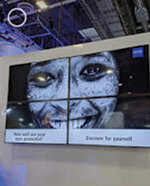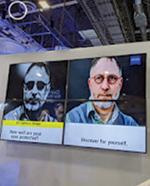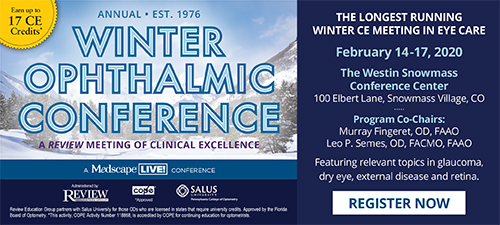
A
weekly e-journal by Art Epstein, OD, FAAO
Off the Cuff: CES 2020
January 2020 started with a blast with the annual CES, the consumer electronics show held yearly in Las Vegas. This was our fourth straight year of attendance, and we’re either in better shape or just accustomed to walking the miles of exhibit halls lined with new technology. From massive high-tech juggernauts to bleeding-edge, barely funded startups, the halls were packed. However, this year, much of what we saw—even CES innovation award-winning products—were fairly pedestrian. Overall, my sense was that this rendition of the CES was more iterative than innovative, with few exceptions. There were definitely a few show-stopping new introductions. For fans of large-screen TVs, several entire-wall-sized 8K monitors were pumping out incredibly vibrant colors and deep immersive sound. Reminiscent of the sci-fi movie-depicted TVs of a decade ago, a single humongous monitor wall with various information, background art and entertainment content concurrently running seemed not that far off. On the medical side of new things, there was lots of activity in the wearables segment, with blood pressure, pulse, EKG and noninvasive blood sugar monitoring displayed at several booths.
|
|||||
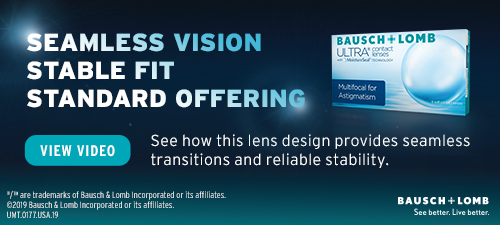 |
||
| Corneal vs. Scleral RGP Lenses for Keratoconus and Other Ectatic Corneal Disorders | ||||
Researchers compared the comfort and visual performance of corneal rigid gas permeable contact lenses (CLs) and scleral rigid gas permeable contact lenses (SLs) in participants with corneal ectasia, successfully wearing "habitual" CLs. In a randomized controlled trial (RCT) with a 2×2 crossover, 34 participants were recruited and randomized into two groups. Group 1 (sequence AB) was fitted in period 1 with new CLs, and after a four-week washout period in which habitual CLs were worn, crossed-over to SLs, period 2. Group 2 (sequence BA) was first fitted with SLs in period 1, and after a washout period of four weeks, crossed-over to new CLs, period 2. The median lengths in weeks of periods 1 and 2 were: 17.5 (IQR 12.4) and 14.5 (IQR 6.2) respectively. The outcome measures for visual performance were best-corrected visual acuity and the contrast sensitivity function. Vision related quality of life (Qol) was assessed using the National Eye Institute Visual Function Questionnaire-25, reported subjective perception of vision (SPV) and reported subjective perception of comfort (SPC) scores, recorded on a scale from 1 to 10. The final outcome measure was the selection of the preferred lens type at the completion of the RCT. For the 30 subjects who completed the trial, significantly higher SPC scores were found for SLs compared to CLs (p=0.002). Significantly higher SPC scores for CLs were found in participants who selected CLs as their preferred lens for future use, compared with those who selected SLs (p=0.009). All other outcomes exhibited no significant difference between the experimental lenses. There was no significant difference (p=0.86) in the proportion preferring CLs (53%) and SLs (47%). Researchers concluded that significantly better comfort was reported for SLs compared with CLs. Significantly higher comfort in CLs was found in those who preferred CLs than those who preferred SLs. Successful CL wearers whose SPC in CLs was <7 were likely to achieve better comfort with SLs. On average, successful CL wearers found SLs more comfortable, and researchers wrote that there were unlikely to be any significant visual or visual Qol advantages or disadvantages in refitting successful CL wearers with keratoconus and other corneal ectasia disorders with SLs, and vice versa.
|
||||
SOURCE: Levit A, Benwell M, Evans BJW. Randomised controlled trial of corneal vs. scleral rigid gas permeable contact lenses for keratoconus and other ectatic corneal disorders. Cont Lens Anterior Eye. 2020; Jan 7. [Epub ahead of print].. |
||||
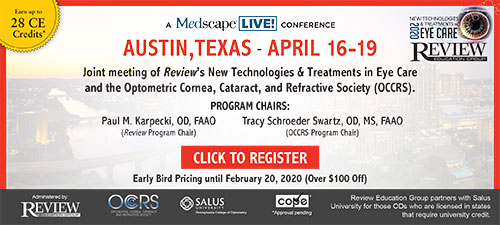 |
||
| Rapid Healing of a Persistent Corneal Epithelial Defect with Autologous Serum Treatment | ||||
Autologous serum drop (ASD) reportedly is a safe and efficient treatment option for most ocular surface diseases. Investigators reported a case of a persistent corneal epithelial defect in a patient treated by ASD. A 28-year old male patient presented to the investigators’ clinic with eye pain and blurry vision in his left eye. Best-corrected visual acuity (BCVA) was 20/20 in the right eye and 20/200 in the left eye. Slit-lamp examination revealed a central corneal epithelial defect on the left eye, and the right eye was normal. The defect appeared after left upper eyelid chalazion surgery and persisted for two months without any response to treatment with eye patching, bandage contact lenses and artificial tear eye drops. Researchers started treatment with ASD six times daily and preservative-free netilmicin drops four times daily to prevent infection. The drops were used simultaneously with patching for the first two days. The eye was left unpatched after the second day. The corneal epithelial defect resolved after 48 hours. Investigators did not detect a new epithelial defect in the follow up visits. As such, they concluded that ASD was a quick, safe and effective treatment option in persistent epithelial defect cases. |
||||
SOURCE: Akagun N, Ozer PA, Gazyagci S. Rapid healing of a persistent corneal epithelial defect (PCED) with autologous serum treatment. Niger J Clin Pract. 2020;23(1):123-5. |
||||
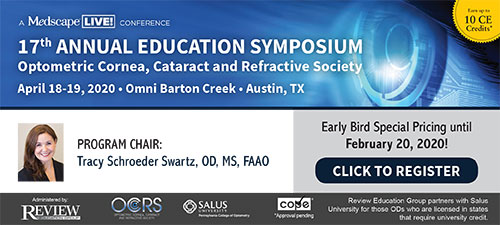 |
||
| Bimatoprost Imprinted Silicone Contact Lens to Treat Glaucoma | ||||
Bimatoprost is widely used for the management of glaucoma. Currently, it is delivered via an eye drop solution, which is highly inefficient due to low bioavailability. To control the release of ocular drugs, contact lenses are used by scientists. However, the conventional soaking method has exhibited a high burst release due to absence of any efficient controlling membrane. Researchers aimed to apply a molecular imprinting technology to improve the loading of bimatoprost from the soaking solution and to sustain the release of drug from the contact lens. The bimatoprost was loaded by conventional soaking method (BT-SM) and compared with the molecular imprinted contact lenses (BT-MP). The loading of bimatoprost by molecular imprinting technology affected the swelling of the contact lens; however, the batch BT-MP-10 did not showed significant alterations. The uptake study showed improvement in bimatoprost loading by molecular imprinting technology in comparison with the conventional soaking technology. The in vitro bimatoprost release data showed improvement in the bimatoprost release rate profiles with BT-MP contact lenses (up to 36 to 60 hours) in comparison with BT-SM contact lenses (up to 24 to 36 hours). The in vivo rabbit tear fluid data with BT-MP batch showed improvement in the bimatoprost retention time in comparison with BT-SM contact lenses and eye drop solution. The rabbit model failed to respond to bimatoprost; thus, researchers suggested the efficacy studies should be conducted on canines or human primates. These findings revealed the potential of using molecular imprinting technology to improve the uptake of bimatoprost and to achieve sustained release kinetics without altering the swelling, transmittance and folding endurance properties of contact lenses. |
||||
SOURCE: Yan F, Liu Y, Han S, et al. Bimatoprost imprinted silicone contact lens to treat glaucoma. AAPS PharmSciTech. 2020;21(2):63. |
||||
| News & Notes | ||||||||
| MacuLogix Introduces AdaptDx Pro, Guided by “Theia” MacuLogix announced the next generation of dark adaptation functional testing with the introduction of AdaptDx Pro, guided by “Theia.” A new headset, custom-designed and tested for patient comfort, includes all of the functionality and accuracy of the company’s table-top dark adaptometer, the company says. As a self-contained wearable headset, the AdaptDx Pro requires no darkroom or external computer, and features an artificial intelligence-driven onboard technician named Theia. After the in-office technician selects the testing protocol and places the device on the patient’s head, Theia takes over to facilitate the testing experience by using automated instructions and adaptive feedback spoken directly to the patient. Theia’s A.I. helps ensure consistent, reliable testing results, and frees up the technician to focus on other tasks, MacuLogix says. The system will make its debut at the SECO (booth #838) and Vision Expo East (booth #MS4733) meetings, the company says. Read more. Read More. |
||||||||
| Oyster Point’s OC-01 Nasal Spray Meets Primary Endpoint Oyster Point Pharma announced positive top-line results from its Phase II MYSTIC study in dry-eye disease. Results showed a statistically significant improvement in Schirmer’s scores from baseline at day 84 in both doses compared with the control, the company says. Read More. |
||||||||
|
||||||||
|
Optometric Physician™ (OP) newsletter is owned and published by Dr. Arthur Epstein. It is distributed by the Review Group, a Division of Jobson Medical Information LLC (JMI), 11 Campus Boulevard, Newtown Square, PA 19073. HOW TO ADVERTISE |

